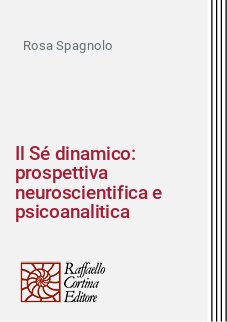Ebook in formato Pdf leggibile su questi device:
-
Android
-
E-Book Reader
-
Ibs Tolino
-
Kobo

| Rivista | La Rivista di Psicoanalisi |
| Fascicolo | Rivista di Psicoanalisi 2023/3 |
| Titolo | Il Sé dinamico: prospettiva neuroscientifica e psicoanalitica |
| Autore | Rosa Spagnolo |
| Editore | Raffaello Cortina Editore |
| Formato |
|
| Pagine | |
| Online da | 10-2023 |
| Doi | 10.26364/RPSA20230690839 |
Il Sé dinamico: prospettiva neuroscientifica e psicoanalitica
I modelli psicoanalitici e neuroscientifici che indagano la relazione mente-cervello includono lo studio della relazione Sé/altro/mondo. Nella sua continuità-discontinuità, il Sé rappresenta il collante soggettivo che informa la nostra esistenza; è caratterizzato da una «durata estesa» in cui il passato persiste nel presente e influenza il futuro. Il Sé è incorporato e allineato al suo rispettivo ambiente temporo-spaziale e si adatta al mondo attraverso questo allineamento temporo-spaziale. Pertanto, il Sé non è incapsulato nella mente, né si basa solo sul nostro corpo, ma si estende oltre la mente e il corpo, includendo il mondo. Senza questa costruzione dinamica spazio-temporale, il Sé apparirebbe discontinuo e frammentato.
Parole chiave: Neuroscienze, psicoanalisi, Relazione Sé-Altro, Sé dinamico, Self continuity, Self embodiment.
The dynamic self: Neuroscientific and psychoanalytic perspective. Psychoanalytic and neuroscientific models investigating the mind-brain relationship include the study of the Self/other/world relationship. In its continuity-discontinuity, the Self represents the subjective glue that informs our existence; it is characterized by an «extended duration» in which the past persists in the present and influences the future. The Self is embedded in and aligned with its respective temporo-spatial environment and adapts to the world through this temporo-spatial alignment. Therefore, the Self is not encapsulated in the mind, nor is it based only on our body, but extends beyond the mind and body to include the world. Without this dynamic space-time construction, the Self would appear discontinuous and fragmented.
Keywords: Dynamic self, neurosciences, psychoanalysis, Self continuity, Self embodiment, Self-Other relationship.
Le soi dynamique: perspective neuroscientifique et psychanalytique. Les modèles psychanalytiques et neuroscientifiques qui étudient la relation esprit-cerveau incluent l’étude de relation soi/autre/monde. Dans sa continuité-discontinuité, le Soi représente le ciment subjectif qui éclaire notre existence; il se caractérise par une «durée prolongée» dans laquelle le passé persiste dans le présent etinfluence l’avenir. Le Soi est intégré et aligné avec son respectif environnement temporo-spatial et s’adapte aumonde à travers cet alignement spatio-temporel. Par conséquent, le Soi n’est pas encapsulé dans l’esprit, et il n’est pas basée uniquement sur notre corps: il s’étend au-delà de l’esprit et du corps pour inclure le monde. Sans cette construction dynamique de l’espace-temps, le Soi apparaîtrait discontinu et fragmenté.
Mots-clés: Neuroscience, psychanalyse, relation Soi-Autre, Soi dynamique, Self continuity, Self embodiment.
El Self dinámico: perspectiva neurocientífica y psicoanalítica. Los modelos psicoanalíticos y neurocientíficos que investigan la relación mente-cerebro incluyen el estudio de la relación Self/otro/mundo. En su continuidad-discontinuidad, el Self representauna especie de ligazónsubjetivo que informa nuestra existencia. Se caracteriza por una «duración prolongada» en la que el pasado persiste en el presente e influye en el futuro. El Self está integrado y alineado con su respectivo entorno temporo-espacial y se adapta al mundo a través de esta alineación temporo-espacial. Por lo tanto, el Self no está encapsulado en la mente, ni se basa únicamente en nuestro cuerpo, sino que se extiende más allá de la mente y el cuerpo, incluido el mundo. Sin esta construcción dinámica espacio-temporal, el Self parecería discontinuo y fragmentado.
Palabras clave: Neurociencias, psicoanálisis, Relación Self-Otro, Self Dinámico, Self-Continuity, Self-Embodiment
Das dynamische Selbst: Eine neurowissenschaftliche und psychoanalytische Perspektive. Die psychoanalytischen und neurowissenschaftlichen Modelle, die das Verhältnis Geist-Gehirn untersuchen, umfassen zugleich die Erforschung des Verhältnisses Selbst/Anderer/Welt. In seiner Kontinuität-Diskontinuität stellt das Selbst das subjektive Bindemittel dar, das unserer Existenz zugrundeliegt; es zeichnet sich durch eine ‚gedehnte Dauer‘ aus, in der die Vergangenheit in der Gegenwart fortbesteht und die Zukunft beeinflusst. Das Selbst ist eingefügt in und ausgerichtet auf seine jeweilige zeitlich-räumliche Umgebung und passt sich durch diese zeitlich-räumliche Ausrichtung an die Welt an. Daher ist das Selbst weder im Geist eingekapselt, noch basiert es ausschließlich auf unserem Körper, sondern erstreckt sich über Geist und Körper hinaus und schließt die Welt mit ein. Ohne diese dynamische raumzeitliche Konstruktion erschiene das Selbst diskontinuierlich und fragmentiert.
Schlüsselwörter: Dynamisches Selbst, Neurowissenschaft, Psychoanalyse, Self continuity, Self embodiment, Verhältnis Selbst-Anderer.